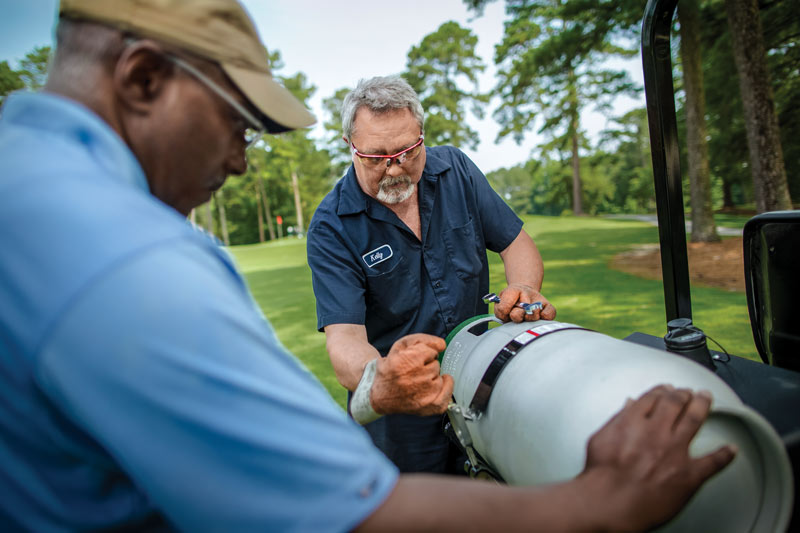
The Propane Education and Research Council (PERC) and R&R Products have been testing propane-powered golf course equipment on eight courses throughout the United States, including Stone Mountain (Ga.) Golf Club by Marriott. Photos courtesy of PERC
Stone Mountain, Ga., is no stranger to revolution.
The granite dome that rises 1,686 feet above the surrounding landscape just 20 miles from downtown Atlanta and the small city that bears the same name both played central roles during the Civil War. The mountain itself features the world’s largest bas-relief sculpture, one that pays homage to that stormy period of history through a carving of Confederate leaders Jefferson Davis, Robert E. Lee and Stonewall Jackson.
Granite quarried from Stone Mountain was used in the construction of the locks in the Panama Canal, the steps to the East Wing of the U.S. Capitol Building and the Imperial Hotel in Tokyo. Martin Luther King Jr. even mentioned the mountain during his famed “I Have a Dream” speech.
The most recent revolution to involve Stone Mountain, however, is playing out far more quietly and discreetly than the area’s previous turns in the spotlight. In fact, those closest to it — those playing 36 holes of golf at Stone Mountain Golf Club by Marriott, which sits in the shadow of the mountain itself — probably have no idea that it’s even taking place.
But, depending on the final outcomes of an innovative program from the Propane Education and Research Council (PERC) and R&R Products that is testing propane-powered golf course maintenance equipment at Stone Mountain and seven other properties across the country, revolutionary is the most apt way to describe what is taking place. It’s a program that has the potential to change the way golf courses all over the world are maintained.
“I really think this is an important step in the evolution of the greening of grounds maintenance,” says Stone Mountain superintendent Anthony Williams, CGCS. “That’s what intrigued me so much about working ... on this project. It’s something that, if successful, can really have an impact on our industry in the future.”
Propane positives
When Walter Snelling first identified propane at the turn of the 20th century, he wasn’t necessarily in search of the world’s next great power source. He was a chemist doing chemist things, and he found that the gases released when gasoline evaporated could be changed back into a liquid form and stored at pressure.
The resulting compound was soon powering everything from home appliances to cutting torches. In the century since its discovery, propane has been adopted for use in kitchens and in laundromats, on road construction projects and on farms from coast to coast.
It also, of course, has been used to power equipment of all shapes and sizes. Forklifts moving in and out of warehouses have long utilized propane as their main power source. Buses in many U.S. cities use propane as a primary fuel source. More recently, propane-powered mowers, seeders and aerators have become staples among lawn and landscape contractors.
When you consider the strengths that propane brings to the table, it’s easy to see why it’s made serious inroads in these areas.
- Cost. All in all, propane is a relatively cost-effective option in most commercial settings when compared with diesel or gasoline. Overall savings can climb as high as 30 percent.
- Environmental impact. Thanks largely to emissions reductions of up to 15 percent versus diesel, propane is considered a strong green option.
- Power. Despite assumptions to the contrary, propane’s power potential is on par with other kinds of fuels. If it’s good enough to power a city bus, it’s probably good enough to power a mower.
- Safety. Propane is an extremely safe and stable fuel source. With the proper training, storing canisters, installing them on equipment and removing them when empty is a simple process.
Part of the progress propane has made in recent years can be credited to PERC, an organization owned, operated and funded by the propane industry that focuses efforts on promoting training and safety, and expanding the adoption of propane as a viable fuel source. That latter mission first led PERC to its work in the lawn and landscape business and, now, to its growing interest in golf.
“In the last seven or eight years, propane as an industry started getting serious about commercial mowing,” says Jeremy Wishart, the deputy director of business development for PERC. “We’ve made some inroads there, had some great successes, so we started looking at where we can next take that model, where the next green pasture might be. Obviously, that led us to look at golf course and resort operations.”
Test drives
It didn’t take long for those initial forays into golf to reveal a natural partner for PERC in the endeavor: R&R Products, which had been offering superintendents propane-powered options on their greens and fairway mowers for several years.
“Jim (Coker, R&R’s director of propane applications) and I began talking about a demonstration program where we could get mowers into the hands of superintendents in real-world settings,” Wishart says. “As we built it out, expanding that to more courses and more superintendents that already had something going on in terms of environmental programs just made more and more sense.”
With the financial backing of PERC, equipment from R&R and additional support from Audubon International — attracted by the potential environmental benefits offered by propane — the program was born.
Its goals were relatively straightforward. PERC and R&R wanted to mine data from the real-world use of propane-powered golf course equipment — from fuel efficiency and emissions reductions to maintenance costs — with the hopes of building a case for superintendents to consider those products as safe, clean and budget-friendly options for their golf courses.
“We know we have a great fuel ... but in practice, we wanted to find out what it’s really like for the guy using it on a day-to-day basis,” Wishart says.
They ultimately identified eight courses spread out across the United States to serve as testing grounds in what would be a year-long program. Those courses received four pieces of equipment — two of R&R’s Reel Max 744LP4 fairway units, and a pair of the company’s Greens Max 2200LF riding greens mowers — along with assistance and instruction on everything from establishing relationships with local propane companies and safe storage practices to tips on the installation of the canisters on the mowers themselves.
One of the courses selected was Stone Mountain, an obvious choice considering Williams’ past accomplishments. He’s received countless environmental accolades (GCSAA’s President’s Award for Environmental Leadership in 2010 among them), is an active force in government affairs, both locally and at the national level, and is renowned for his management of the 36-hole Stone Mountain facility with a crew of just 15 and a budget with few frills.

Stone Mountain crew member Robert Brown (left) and equipment technician Kelly Biddy work on a fairway unit. Courses participating in PERC and R&R Products’ testing program are trained thoroughly on the use of the propane-powered equipment, including the installation and removal of canisters from each unit.
“We felt like we were a great fit for a program like this,” Williams says. “We felt like we could represent ‘the little guy’ a little bit, and if we could do this here, then it could be done just about anywhere.”
That doesn’t mean there wasn’t some initial reluctance from some of Williams’ longtime lieutenants.
“If you grew up in this industry and you’ve only been on a Toro or John Deere greens mower, and all of a sudden this R&R truck shows up with equipment that has propane tanks strapped to them, you kind of have to take a moment and take that all in,” the 19-year GCSAA member says.
“As I told them, it’s still a horse. You’ve just never ridden a horse that looks quite like this.”
Overcoming that reluctance and the other myriad concerns that come along with anything new in an industry rooted in tradition fell largely to R&R’s Coker, who was responsible for delivering the equipment to each of the participating courses and leading training sessions for the operators of those machines.
He acknowledges that reactions similar to the ones experienced at Stone Mountain were the rule rather than the exception. But at nearly every course, those reactions were short-lived.
“When I came in and trained these guys, I tried to focus on the benefits and the safety aspects,” Coker says. “For example, there are a lot of concerns that the tanks were going to blow up like they see in the movies, which couldn’t be farther from the truth. We just had to get them comfortable with how you stored tanks, how you put them on and took them off the mowers. Once that happened, you could see the light bulb go on a little bit.”
A real revolution?
The early reviews from the team at Stone Mountain do hint at significant potential for propane in golf course management, if not as a straight replacement for traditional diesel units, then at least as a realistic alternative to them.
When GCM visited Stone Mountain earlier this year, Williams was just a few months into the program and was already realizing cost savings — a year-over-year drop of more than $2,000 at that point. “That’s with only a couple of months of use, none of it in our heavy mowing season, and with only four parts of our fleet using propane,” he explains.
He also had already come to see the real environmental benefits that propane could offer, even beyond emissions reductions. “Anyone who has ever had to close and remove an underground storage tank can tell you how expensive it is, how much hot soil is left behind,” Williams says. “Being able to eliminate the potential for spillage and seepage, to protect wildlife and soil quality, is huge. You’re just taking unwanted risk out of the equation.”

Kelly Biddy pilots a propane-powered greens mower on the fifth hole of the Lakemont Course at Stone Mountain.
For his part, Williams’ equipment manager at Stone Mountain, Jim Stuart, was also a quick study with the new machines.
“There really hasn’t been any differences at all (between propane and diesel mowers),” Stuart says. “It goes on the lift; I check it out just like I would any other piece of equipment we have. Honestly, I’m looking forward to the fact that I don’t have to change the oil half as much as I used to.”
So are the takeaways from Stone Mountain and the seven other facilities participating in the program enough to signal an impending revolution in golf course management? Williams isn’t ready to make such a broad proclamation just yet. But he does think superintendents should at least give propane-powered equipment a try, and then make that judgment for themselves.
“There’s been plenty of curiosity among other superintendents in our area,” Williams says. “I think right now they’re going to wait and see how it goes.
“But I would just encourage anyone who is curious about it and has the flexibility to try these machines to do just that. Ask your questions, put them on your course, and see what you think. That’s really the spark of genius to this program, I think. They’re not just selling the products. They’re getting them in the field on some diverse golf courses, and they’re seeing how they perform.”
Fueled up
The following eight courses are taking part in a research program focused on propane-powered golf course maintenance equipment organized by the Propane Education and Research Council and R&R Products:
- Stone Mountain (Ga.) Golf Club by Marriott; Anthony Williams, CGCS
- Fernandina Beach (Fla.) Golf Club; Rip Phillips, GCSAA Class A superintendent
- Marriott Desert Springs Golf Club, Palm Desert, Calif.; Matthew Hoyt, CGCS
- The Vinoy Renaissance St. Petersburg (Fla.) Resort and Golf Club; Scott Corwin, GCSAA Class A superintendent
- Columbus (Ohio) Municipal Golf Courses; Bill Burns, fleet operations manager
- Reston (Va.) National Golf Course; Patrick Swedock, GCSAA Class A superintendent
- George W. Dunne National Golf Course, Oak Forest, Ill.; Jeremy Turton, GCSAA Class A superintendent
- Eagles Pride Golf Course, Joint Base Lewis-McChord, Wash.; John Ford, CGCS
Scott Hollister is GCM’s editor-in-chief.